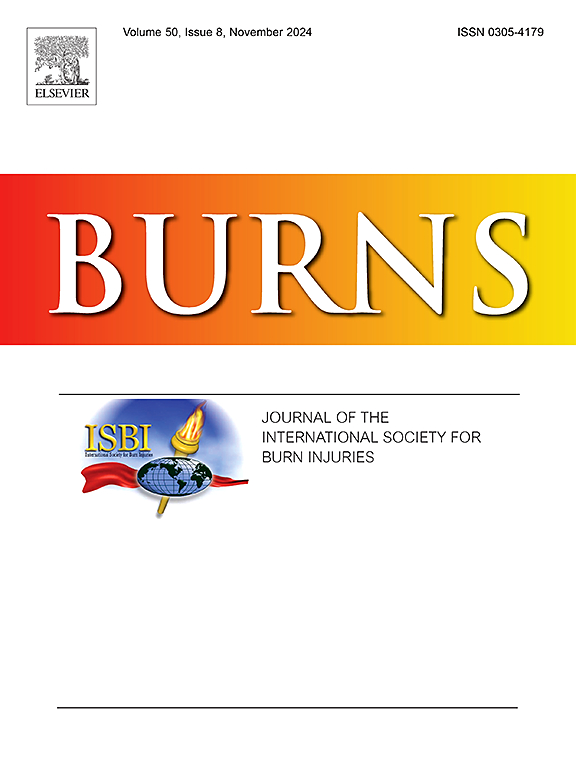Ferroptosis and necroptosis may be involved in the formation and progression of hydrofluoric acid burn wounds: Results from an RNA-Seq analysis
IF 3.2
3区 医学
Q2 CRITICAL CARE MEDICINE
引用次数: 0
Abstract
Background
Hydrofluoric acid (HF) burns have potentially serious consequences. The molecular mechanism of wound development is still unclear. This study aims to preliminarily explore the programmed cell death mode that may be involved in hydrofluoric acid burns by using transcriptome sequencing technology and to provide a theoretical basis for a new treatment approach for hydrofluoric acid burns.
Methods
The rat model of hydrofluoric acid burn skin was constructed, and the differentially expressed genes after HF burn were screened by transcriptome sequencing technology. HE staining, TUNEL staining, immunohistochemistry, biochemical detection, and qRT-PCR were used to preliminarily verify the mode of cell death involved in hydrofluoric acid burn wounds.
Results
The sequencing results suggest that the differential genes after HF burn were enriched in ferroptosis, apoptosis, and necroptosis pathways in cell growth and death aspects. HE staining confirmed HF burn wounds were progressively aggravated. The positive cells of TUNEL staining in the wound gradually increased. Compared with the normal group, the content of MDA in serum and skin tissue increased and the content of GSH decreased at 4, 8, 12, 24, and 48 hours after HF burn (P < 0.05). The level of serum Fe2 + in the HF burn group was higher than that in the normal group at 4 h, 8 h, and 12 h postburn (P < 0.05). The level of serum Fe2+ at 24 h and 48 h postburn was higher than that of the normal group, but the difference was not statistically significant. The content of Fe2+ in skin tissue increased and reached its peak at 12 h (P < 0.05). The serum calcium level decreased to its lowest level at 24 hours postburn (P < 0.05). Immunohistochemistry showed that the expressions of GPX4, FTH1, and Bcl-2 proteins in hydrofluoric acid burn wounds were down-regulated, while the expression of HO-1, Bax, RIPK1, and MLKL was increased (P < 0.05). RIPK3 expression was not significantly different. qRT-PCR showed that the expression of HO-1, FTH1, SLC39A14, SLC39A8, CYBB, ACSL4, Bax, RIPK1, MLKL, IL-1β, and IL-6 increased, while the expression of ACSL1, ACSL6, GPX4, and Bcl-2 decreased after hydrofluoric acid burn compared with the normal group (P < 0.05). The RIPK3 gene expression did not change significantly.
Conclusions
Ferroptosis and necroptosis are involved in the formation and progression of HF burn wounds. Early blocking of ferroptosis may be a potential therapeutic for blocking the progress of hydrofluoric acid burn wounds. Necroptosis involvment in the occurrence and development of hydrofluoric acid burn wounds may be a non-classical pathway.
铁下垂和坏死性下垂可能参与氢氟酸烧伤创口的形成和发展:来自RNA-Seq分析的结果
背景氢氟酸(HF)烧伤具有潜在的严重后果。创面发育的分子机制尚不清楚。本研究旨在通过转录组测序技术,初步探索氢氟酸烧伤可能涉及的细胞程序性死亡模式,为氢氟酸烧伤新的治疗途径提供理论依据。方法建立氢氟酸烧伤大鼠皮肤模型,利用转录组测序技术筛选氢氟酸烧伤后的差异表达基因。采用HE染色、TUNEL染色、免疫组织化学、生化检测、qRT-PCR等方法初步验证氢氟酸烧伤创面细胞死亡模式。结果测序结果表明,HF烧伤后的差异基因在细胞生长和死亡方面富集于铁下垂、凋亡和坏死下垂途径。HE染色证实HF烧伤创面逐渐加重。创面TUNEL染色阳性细胞逐渐增多。与正常组比较,HF烧伤后4、8、12、24、48 h血清和皮肤组织中MDA含量升高,GSH含量降低(P <; 0.05)。HF烧伤组血清Fe2 +水平在烧伤后4 h、8 h、12 h均高于正常组(P <; 0.05)。烧伤后24 h和48 h血清Fe2+水平高于正常组,但差异无统计学意义。皮肤组织中Fe2+含量增加,在12 h时达到峰值(P <; 0.05)。血钙水平在烧伤后24 h降至最低(P <; 0.05)。免疫组化结果显示,氢氟酸烧伤创面GPX4、FTH1、Bcl-2蛋白表达下调,HO-1、Bax、RIPK1、MLKL表达升高(P <; 0.05)。RIPK3表达差异无统计学意义。qRT-PCR结果显示,与正常组比较,氢氟酸烧伤后HO-1、FTH1、SLC39A14、SLC39A8、CYBB、ACSL4、Bax、RIPK1、MLKL、IL-1β、IL-6表达升高,ACSL1、ACSL6、GPX4、Bcl-2表达降低(P <; 0.05)。RIPK3基因表达无明显变化。结论HF烧伤创面的形成和发展与铁下垂和坏死下垂有关。早期阻断铁下垂可能是阻断氢氟酸烧伤创面进展的一种潜在治疗方法。坏死性上睑下垂参与氢氟酸烧伤创面的发生和发展可能是一个非经典途径。
本文章由计算机程序翻译,如有差异,请以英文原文为准。
求助全文
约1分钟内获得全文
求助全文
来源期刊

Burns
医学-皮肤病学
CiteScore
4.50
自引率
18.50%
发文量
304
审稿时长
72 days
期刊介绍:
Burns aims to foster the exchange of information among all engaged in preventing and treating the effects of burns. The journal focuses on clinical, scientific and social aspects of these injuries and covers the prevention of the injury, the epidemiology of such injuries and all aspects of treatment including development of new techniques and technologies and verification of existing ones. Regular features include clinical and scientific papers, state of the art reviews and descriptions of burn-care in practice.
Topics covered by Burns include: the effects of smoke on man and animals, their tissues and cells; the responses to and treatment of patients and animals with chemical injuries to the skin; the biological and clinical effects of cold injuries; surgical techniques which are, or may be relevant to the treatment of burned patients during the acute or reconstructive phase following injury; well controlled laboratory studies of the effectiveness of anti-microbial agents on infection and new materials on scarring and healing; inflammatory responses to injury, effectiveness of related agents and other compounds used to modify the physiological and cellular responses to the injury; experimental studies of burns and the outcome of burn wound healing; regenerative medicine concerning the skin.
 求助内容:
求助内容: 应助结果提醒方式:
应助结果提醒方式:


